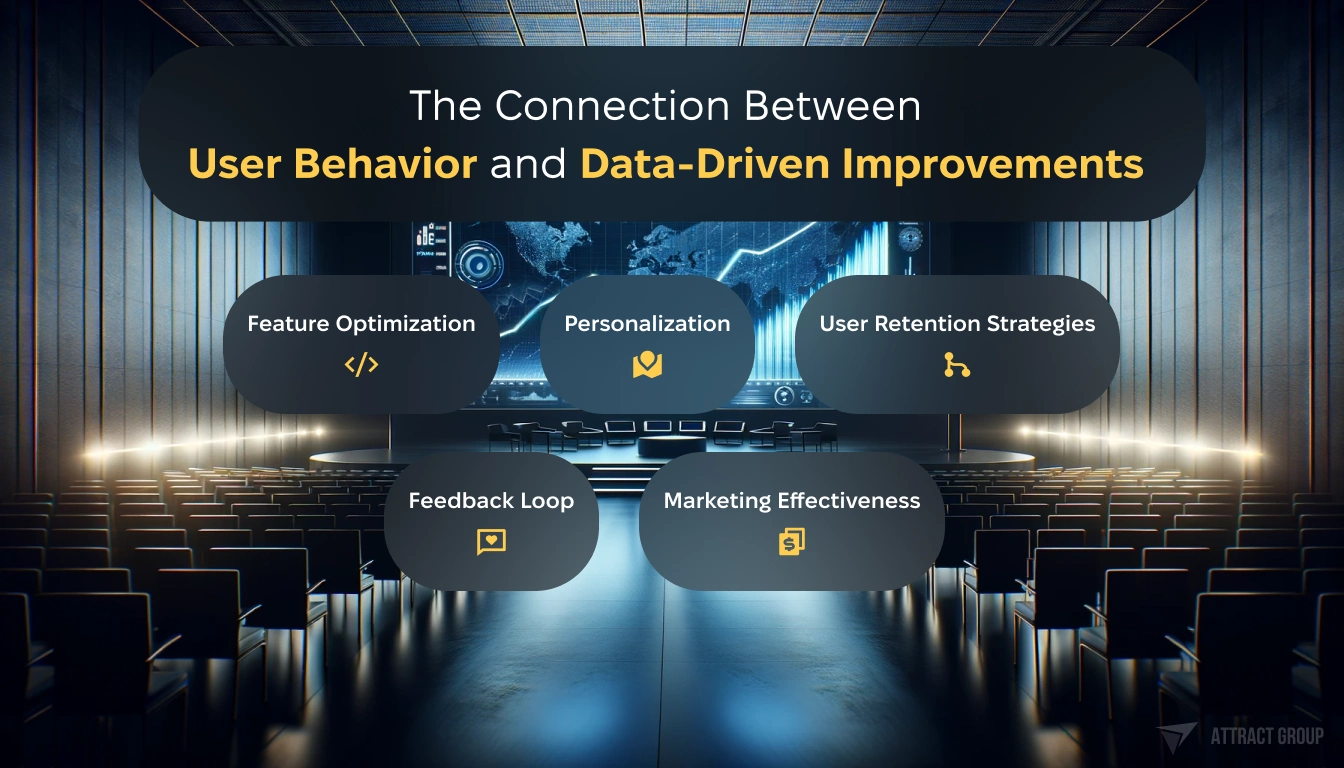Mastering Mobile App Analytics: Tracking Key Performance Metrics
 20 November 2023
20 November 2023Mobile apps have become an integral part of our daily lives. From ordering food to booking a ride, we rely on these apps to simplify various tasks. However, the success of a mobile app goes beyond its functionality and design. It requires a deep understanding of user behavior and preferences, which can be achieved through mobile app analytics.
Mobile app analytics involves tracking key performance metrics to gain valuable insights into user engagement, retention, and overall app performance. By harnessing the power of tools like Adobe Analytics mobile app metrics, app Annie analytics API metrics, and Google Analytics Firebase, businesses can measure the effectiveness of their app and make data-driven decisions.
We will delve into mobile app analytics, exploring key metrics, their importance in the app lifecycle, and how to calculate all the essential metrics for a mobile app lean analytics. Whether you’re a technical business owner or a marketing professional, this article will equip you with the knowledge to master mobile app analytics and drive success for your app.
Understanding the Foundation: What Are Mobile App Analytics?
Mobile app analytics are fundamentally the processes that capture data on user interaction with an app, offering insights that help enhance user engagement. The role of app analytics is integral to identifying the most utilized features and understanding the segments of users, which directly informs user acquisition, retention strategies, and content personalization.
Defining Mobile App Analytics and Their Role in User Engagement
Mobile app analytics can be defined as the systematic collection, measurement, and interpretation of user data from various touchpoints within an app, aiming at improving the overall user experience and achieving business objectives. By implementing user analytics into app development and marketing strategies, businesses can fine-tune user engagement and achieve stronger mobile user retention.
Analyzing user behavior within an app allows marketers and developers to:
- Identify and prioritize features that drive user engagement
- Personalize content and offers based on user preferences
- Optimize the app’s user interface (UI) for better user experience (UX)
- Develop efficient user acquisition and retention campaigns
The Process: How Mobile App Analytics Work
The mobile app analytics process involves the following steps:
- Data collection: Capturing user interactions, including device and operating system (OS) details, app versions, session times, and user behaviors.
- Data transmission: Sending the collected data to analysis servers for processing and secure storage.
- Data analysis: Processing data and turning it into valuable insights using various techniques such as video/image analysis or reconstruction of user sessions using low-level commands as implemented by tools like Microsoft Clarity.
- Data visualization: Presenting the analyzed data through actionable reports, charts, and graphs to provide a comprehensive understanding of user behavior and app performance.
To ensure an effective mobile app analytics process, it is crucial to track the right metrics and leverage advanced tools like Google Analytics Firebase for data analytics. Additionally, following best practices for data privacy and security is essential to maintain user trust and comply with regulatory requirements.
| Key Component | Description |
|---|---|
| Data Collection | Gathering user interaction data within an app |
| Data Transmission | Sending collected data to analysis servers |
| Data Analysis | Processing data and deriving valuable insights |
| Data Visualization | Presenting insights through reports, charts, and graphs |

The Role of Analytics in Mobile App Development
Analytics plays a crucial role in shaping strategies and guiding decision-making. Businesses can gain profound insights into user behavior, market trends, and app performance by leveraging data from various sources.
This process is not just about gathering data, and it’s about translating it into actionable strategies that align with business objectives. For technical business owners, understanding the role of analytics is key to ensuring their mobile applications meet and exceed market expectations.
How Analytics Inform Strategy and Decision-Making?
Analytics serves as the backbone for strategic decision-making in mobile app development. It provides a comprehensive view of the app’s performance, user engagement, and market position. Here’s how analytics contributes to informed decision-making:
- Accurate Forecasting: Analyzing historical data helps predict future trends, enabling businesses to prepare and adapt accordingly.
- Risk Assessment: It identifies potential risks and challenges, allowing for proactive measures to mitigate them.
- Performance Evaluation: Analytics assesses the effectiveness of various app features and marketing strategies, guiding improvements.
- Market Trends and Customer Preferences: It reveals insights into market shifts and user preferences. Which are crucial for staying relevant and competitive.
- Predictive Analysis: Utilizing advanced analytics tools, businesses can anticipate user needs and market changes, staying ahead of the curve.
The integration of analytics into mobile app development goes beyond mere data collection. It’s about dissecting and understanding patterns, behaviors, and trends to make well-informed, strategic decisions. From choosing the right features to implementing effective marketing strategies, analytics empowers businesses to make decisions based on facts, not assumptions.
The Connection Between User Behavior and Data-Driven Improvements
Understanding user behavior is pivotal in enhancing app performance and user experience. Analytics provides a window into how users interact with your app, offering insights that drive improvements:
- Personalization: Analytics helps tailor the user experience to individual preferences, boosting engagement and satisfaction.
- Feature Optimization: Businesses can focus on enhancing features by understanding which features are most used and appreciated.
- User Retention Strategies: Insights into user behavior guide the development of strategies to increase retention.
- Feedback Loop: Analytics enables a responsive approach to user feedback, ensuring continuous improvement.
- Marketing Effectiveness: It helps refine marketing strategies by understanding user responses and engagement patterns.

Begin with a brainstorm session with our experts team
Key Mobile App Metrics to Monitor
Mastering mobile app analytics is crucial for technical business owners looking to optimize their app’s performance and user experience. By closely monitoring key performance metrics, businesses can gain invaluable insights into how users interact with their app, identify areas for improvement, and make data-driven decisions to enhance user engagement and satisfaction.
Importance of Mobile App Metrics
Mobile app metrics offer a detailed understanding of user behavior, app performance, and business impact. These metrics help identify trends, understand user preferences, and track marketing strategies’ effectiveness.
With the right analytics tools, businesses can fine-tune their mobile platforms, ensuring they meet user needs and maximize ROI. By leveraging analytics software like App Annie, Flurry Analytics, and Adobe Analytics, businesses can extract meaningful data to improve app performance and user experience.
Top Key Mobile App Metrics
| Metric | Description | Importance | How to Measure |
| User Engagement | Measures how actively users interact with the app. | Indicates app’s value and stickiness. | Analyze average daily sessions, time spent, and in-app actions. |
| Performance Indicators | Tracks app’s operational aspects like load time and crashes. | Reflects app’s reliability and user experience quality. | Use tools like AppDynamics and analytics software to monitor. |
| Lifetime Value (LTV) | Estimates the total revenue a user will generate. | Helps in assessing long-term profitability. | Analyze purchase history and subscription renewals. |
| Churn Rate | Percentage of users who stop using the app. | Indicates user retention and satisfaction. | Track the number of deactivated or uninstalled apps. |
| Cost Per Install (CPI) | The cost incurred for each app installation. | Useful for measuring marketing campaign effectiveness. | Calculate by dividing the total ad spend by the number of installs. |
| Active Users | Number of users who actively use the app. | Gauges app’s popularity and reach. | Track daily and monthly active users. |
| Conversion Rate | Percentage of users who complete desired actions. | Measures effectiveness in driving user actions. | Analyze completions of specific in-app events. |
| App Downloads | Total number of times the app is downloaded. | Basic metric for initial app popularity. | Monitor via app store analytics and web and mobile app analytics. |
| Return on Investment (ROI) | Financial return from the app. | Critical for assessing the app’s business value. | Calculate by comparing revenue against investment costs. |
| App Rating & Reviews | User-given ratings and feedback. | Provides direct user feedback and satisfaction level. | Monitor on app stores and use tools like App Radar for analysis. |
| Acquisition Metrics | Data on how users find and install the app. | Helps in optimizing marketing strategies. | Analyze channel effectiveness, CPA, and user demographics. |
| Revenue Metrics | Income generated from the app. | Indicates financial success and growth potential. | Track in-app purchases, subscriptions, and ad revenue. |
Utilizing Mobile App Analytics Tools
Choosing the right mobile app analytics platform is essential. Tools like Google Analytics, Apple App Analytics, and paid mobile app analytics provide real-time analytics and in-depth insights into app usage and user behavior. These tools can help optimize your app, making it more appealing and user-friendly.
Mastering mobile app analytics through tracking key performance metrics is essential for technical business owners. By utilizing advanced mobile analytics solutions, businesses can enhance the app experience, improve app development, and ultimately drive success in the competitive mobile app market.

Acquisition Metrics
Mastering Mobile App Analytics: Tracking Key Performance Metrics
In the dynamic world of mobile applications, understanding and optimizing user acquisition is crucial for success. In mobile app analytics, acquisition metrics are the cornerstone for businesses to evaluate their app’s performance and user engagement.
These metrics are not just numbers but represent real user interactions and preferences, providing invaluable insights for technical business owners.
By tracking and analyzing these metrics, businesses can refine their strategies to attract more viable customers, enhancing the app’s popularity and profitability.
1. Tracking Downloads and Installations with Google Analytics Mobile App Metrics
Google Analytics offers a robust framework for tracking mobile app metrics, focusing on downloads and installations. This tracking is essential for several reasons:
- Measuring Reach: It quantifies the app’s market penetration and helps understand its reach among the target audience.
- User Engagement Insights: Businesses can gauge user interest and engagement levels by tracking installation trends.
- Marketing Effectiveness: This data helps evaluate the effectiveness of marketing campaigns and promotional strategies.
- User Behavior Analysis: Patterns in downloads and installations can reveal user preferences and behaviors, informing future app enhancements and marketing tactics.
2. Understanding Sources and Methods of User Acquisition
Gaining insights into how users discover and download your app is crucial. Here are some key methods and sources to consider:
- App Store Optimization (ASO): Optimizing your app’s listing in app stores to improve visibility and appeal to potential users.
- Referral Tracking: Analyzing how users are referred to your app, whether through advertising, word-of-mouth, or other channels.
- Social Media Campaigns: Leveraging social media platforms to reach and engage with potential users.
- Paid Advertising: Utilizing paid ads on various platforms to target specific demographics and interests.
- Partnerships and Collaborations: Partnering with other companies or influencers to promote your app.

Additional Resources:
- Google Analytics for Mobile Apps – Google’s official resource for learning about mobile app metrics.
- Mobile App Acquisition Strategies – Forbes Tech Council offers insights on effective user acquisition strategies.
- Understanding Mobile App Analytics – Gartner’s research on analytics and performance measurement.
- ASO Guide – App Annie’s comprehensive guide on App Store Optimization.
- Mobile Marketing Association – A resource for mobile marketing and analytics insights.
Leveraging Google Analytics mobile app metrics and understanding diverse acquisition channels are pivotal for any technical business owner in the app domain. By employing these analytics and strategies, you can enhance your app’s performance, reach a wider audience, and ultimately achieve your business objectives.
User Engagement Metrics
Understanding user engagement is pivotal for the success of mobile applications. User engagement metrics offer insights into how users interact with an app, highlighting areas of strength and opportunities for improvement. These metrics are not just numbers but are vital indicators of user satisfaction, app performance, and overall business health.
By tracking key performance metrics, businesses can tailor their strategies to enhance user experience, increasing retention and maximizing value. This is particularly important in a market where personalized experiences and efficient app performance are key differentiators.
With tools like Google Analytics, Appdynamics, and other mobile app analytics platforms, measuring and interpreting these metrics becomes a streamlined part of the mobile strategy.
1. Depth Look at Mobile App Analytics Metrics for Measuring Active Users
| Metric | Description | Importance | Measurement Technique |
| Daily Active Users (DAU) | The number of unique users who engage with the app daily | Indicates daily app engagement and stickiness | Count of unique users per day |
| Monthly Active Users (MAU) | Unique users engaging with the app in a month | Reflects monthly user retention and reach | Count of unique users per month |
| Session Interval | Time between user’s sessions | Shows the user’s habit in returning to the app | Time difference between sessions |
| User Retention Rate | Percentage of users who return to the app | Measures loyalty and long-term engagement | Ratio of returning users over a specific period |
2. Techniques to Measure Session Length and Frequency
Session length and frequency are crucial metrics in mobile app analytics, providing insights into how long and often users engage with an app. The session length is measured from when users open the app to when they close it or switch to another.
This metric is often tracked using mobile app analytics tools available in the market, such as Google Analytics and Appdynamics, which automatically record these durations.
Frequency, however, refers to how often users open the app within a given time frame. It is calculated by counting the number of sessions per user over daily, weekly, or monthly intervals.
These metrics help understand user engagement patterns, identify peak usage times, and tailor content or features to enhance user experience. Analyzing these metrics allows businesses to optimize their app performance, ensuring they meet user expectations and encourage them to continue using the app.
Retention and Churn Metrics
Retention and churn are two critical metrics In mobile app analytics. These metrics offer insights into user engagement and highlight your app’s health in a competitive market. Retention rates are a barometer for app stickiness, revealing how compelling and useful your app is for users over time.
On the other hand, churn rates provide a clear picture of user disengagement, indicating the percentage of users who stop using your app. Understanding and optimizing these metrics is essential for technical business owners aiming to maintain a sustainable and growing user base.
1. Calculating Retention Rates to Measure App Stickiness
Retention rate is vital for assessing how well your mobile app resonates with its user base. It measures the percentage of users who return to your app after their first visit. To calculate the retention rate, we need to know how to calculate all the essential metrics for a mobile app lean analytics and also divide the number of users who continue to use your app after a certain period by the number of users who initially installed it.
This metric is crucial for apps in various sectors, particularly in discretionary or trend-driven markets like retail. For example, an average retailer cohort churn rate ranges between 20% to 40%. In such volatile sectors, a strong retention rate signifies that the app offers value, compelling users to revisit.
A notable case is the Etsy app, which continues to engage a significant user base despite a high cohort churn rate. Understanding and enhancing retention rates through effective strategies can significantly improve your app’s market position and user loyalty.

2. Identifying Churn Signals and Counteracting Them
Churn, or the rate at which users abandon your app, is a critical metric that needs constant monitoring. To manage churn effectively, it is essential to identify its signals and implement mitigation strategies. The following table presents common churn signals and corresponding countermeasures:
| Churn Signal | Countermeasure |
| Decrease in User Engagement | Implement personalized features, improve app experience |
| Negative Feedback/Reviews | Address user concerns, update app based on feedback |
| Low Session Frequency/Duration | Enhance app content, introduce engaging features |
| Technical Issues (crashes, bugs) | Regular app testing and updates, implement crash analytics |
| Market Trends (e.g., high churn in BNPL apps) | Analyze competitor’s adapt to market needs |
For instance, in the “buy now, pay later” (BNPL) app category, companies like Affirm and Klarna have witnessed high churn rates. This signals a need for these apps to revitalize their user engagement strategies and focus on resurrecting former users to offset the churn.
Incorporating a robust mobile app analytics platform into your strategy is indispensable. It helps you track app downloads, user engagement, and performance metrics.
Utilizing Flurry Analytics, App Annie, or Apple App Analytics can provide real-time analytics and insights into app usage, helping you optimize your app for better performance and user experience. By leveraging these tools, you can improve your app and stay ahead in the dynamic analytics world, ensuring your mobile strategy aligns with user expectations and market trends.
Conversion Metrics
Conversion metrics are a cornerstone in mobile app analytics, offering invaluable insights for technical business owners. These metrics measure the success rate of converting users to customers and offer a comprehensive view of user interaction and behavior through various stages of the app experience.
- From User to Customer: This conversion process is pivotal for any mobile app. By tracking specific app analytics metrics, business owners can understand how effectively their app converts a casual user into a paying customer. This conversion involves several stages, from a user’s first interaction with the app to purchasing or subscribing to a service. Key metrics in this process include the app store conversion rate, which reflects the effectiveness of your app’s listing in persuading people to install it. Monitoring these metrics helps optimize app features and marketing strategies to boost conversion rates.
- Understanding the Funnel with Google Analytics: Google Analytics provides a comprehensive mobile app metrics service, enabling a deep dive into user behavior. This platform helps map out the user’s journey, identifying at which stage potential customers are lost and where they convert. It’s essential for understanding the sales funnel in the context of a mobile app. By analyzing this funnel, businesses can pinpoint areas for improvement, such as app performance, user interface, and marketing tactics.
Mastering mobile app analytics is crucial for measuring key performance metrics in the broader context. This encompasses a range of areas, including engagement (daily and monthly active users, retention rate, churn rate), app performance (app crashes, load time, latency), and return on investment (cost per install, customer lifetime value). Additionally, app ratings and reviews offer direct feedback from users, which is integral for continuous improvement.

Integrating tools like Adobe Analytics, App Annie, and other mobile app analytics software further enriches the understanding of how users interact with your app. These analytics platforms provide detailed insights into user behavior, app performance, and market trends, all essential for maintaining a competitive edge in the app market.
For technical business owners, it is imperative to continually understand and utilize these metrics and analytics to assess and enhance their mobile applications’ performance. By leveraging these insights, businesses can make informed decisions, tailor their marketing strategies, and ultimately drive growth and success in the dynamic mobile app market.
Advanced Analytics Techniques
Advanced analytics is crucial in mobile app analytics by providing deep insights into user behavior, app performance, and market trends. These techniques extend beyond traditional business intelligence, enabling technical business owners to uncover hidden patterns, predict future trends, and make informed decisions.
Businesses can gain a competitive edge by leveraging advanced analytics, particularly in mobile app development and optimization. The key is gathering data and analyzing and interpreting it effectively to enhance user experience, increase engagement, and drive growth.
List of Advanced Analytics Techniques
| Technique | Description | Application in Mobile App Analytics | Benefit |
| Data Mining | Sorting through large datasets to identify patterns and relationships. | Analyzing user data to improve app features and user experience. | Helps in understanding user behavior and preferences. |
| Sentiment Analysis | Analyzing text data to determine the emotional tone behind words. | Evaluating user reviews and feedback to gauge app reception. | Aids in measuring user satisfaction and making improvements. |
| Cluster Analysis | Grouping similar items in a dataset. | Segmenting app users based on behavior or preferences for targeted marketing. | Enhances personalization and marketing strategies. |
| Complex Event Processing | Analyzing events across systems in real time to detect patterns. | Monitoring app performance and user interactions for immediate insights. | Enables quick response to issues or opportunities. |
| Recommender Systems | Using past behavior to predict user preferences. | Personalizing app content and recommendations for each user. | Improves user engagement and experience. |
| Time Series Analysis | Analyzing data changes over time to predict future trends. | Forecasting app usage trends and planning resource allocation. | Assists in strategic planning and decision-making. |
| Big Data Analytics | Examining large volumes of data to uncover patterns and trends. | Analyzing extensive user data for market trends and preferences. | Provides comprehensive insights for strategic decisions. |
| Machine Learning | Using AI for predictive analytics and data processing. | Enhancing app features and personalization based on user behavior. | Improves accuracy in predictions and user targeting. |
| Data Visualization | Presenting data in a graphical format for easier analysis and sharing. | Visualizing app analytics for quick understanding and decision-making. | Simplifies complex data, making it accessible to non-technical stakeholders. |
Utilizing Google Analytics Mobile App Metric Converter for Complex Data
Google Analytics offers a mobile app metric converter that simplifies the analysis of complex app data. This tool helps transform raw data into actionable insights, which is crucial for app developers and business owners.
Users can easily track key performance indicators (KPIs) like user engagement, retention rates, and app performance by converting intricate metrics into understandable formats. This not only aids in monitoring the app’s current state but also in strategizing future enhancements and marketing efforts.
Calculating Essential Metrics with Lean Analytics Methodologies
Lean analytics methodologies focus on measuring and analyzing the most critical metrics that directly impact the success of a mobile app. Essential metrics include user acquisition, engagement, retention, and monetization. Adopting a lean approach can quickly identify which aspects of the app are performing well and which need improvement.
This method involves setting clear goals, choosing relevant metrics, analyzing them efficiently, and iterating based on the findings. The goal is to make informed decisions quickly and efficiently, ensuring the app meets the needs of its users and the business objectives.

Using Analytics for User Experience Enhancement
Using analytics to map user journeys in data analytics metrics media apps is crucial for understanding how users interact with your application. This involves tracking their actions from the moment they open the app to the point of conversion or exit.
You can identify patterns and pain points in the user journey by analyzing data such as app version metrics, Google Analytics, Firebase insights, and other mobile app performance metrics. This information is invaluable for enhancing user experience, as it allows you to tailor the app to meet users’ needs more effectively.
Table: Key Metrics for Mapping User Journeys in Media Apps
| Metric Category | Description | Example Metrics | Tools |
| Engagement | Measures how users interact with the app | Time spent on app, pages viewed | Google Analytics, App Annie |
| Performance | Tracks the app’s operational efficiency | App load time, crash analytics | AppDynamics, Firebase |
| Conversion | Monitors achievement of specific goals | Subscription rates, in-app purchases | Google Analytics, Lean Analytics |
| Retention | Assesses how well the app keeps users over time | Daily active users, retention rate | Behavioral Analytics, Retention Analytics |
Leveraging Metrics to Refine and Customize the User Experience
Refining and customizing the user experience through metrics involves a deep dive into data analytics. By tracking and analyzing key metrics for app analytics, such as mobile app performance metrics, behavioral analytics, and app retention rates, businesses can gain insights into user behavior within the app.
- App Version Metric & Google Analytics Firebase: Monitoring app version metrics through tools like Google Analytics and Firebase is essential for understanding how different versions perform and impact user experience.
- AppDynamics & Mobile App Performance Metrics: Utilizing AppDynamics for mobile app performance metrics can significantly aid in identifying and resolving issues that affect user experience.
- Data Analytics Metrics & Media App: Data analytics metrics are integral in optimizing a media app’s performance and user engagement.
- Google Analytics Mobile App Metric Converter: This tool can help convert complex data into understandable metrics, aiding in better decision-making for app enhancements.
- How to Calculate Essential Metrics for Mobile App Analytics: Understanding essential metrics is key to successfully leveraging mobile app analytics for user experience enhancement.
- Key Metrics for App Analytics & Behavioral Analytics: Identifying key metrics for app analytics, particularly behavioral analytics, helps create a more engaging and personalized app experience.
- Mobile App Analytics Metrics & Retention Analytics: Mobile app analytics metrics, especially those related to retention analytics, are crucial for understanding and improving user retention.
- App Analytics Tools Help & Crash Analytics: Tools that provide crash analytics and other analytics insights help refine the app to improve performance and user satisfaction.
- Choosing an Analytics Vendor & Mobile App Analytics Platform: Choosing the right analytics vendor or platform is a critical step in the analytics process, ensuring the collection of relevant data for enhancing user experience.
Tools like Google Analytics and Firebase offer detailed metrics that help you track user engagement and identify areas for improvement. By understanding these metrics, businesses can implement changes that improve app performance, leading to a more personalized and effective mobile strategy. This customized approach enhances user experience and increases the likelihood that users will continue to use your app, thereby boosting overall app success.

Conclusion
In a competitive app marketplace, mastering mobile app analytics and tracking key performance metrics is essential. Data analytics metrics for media apps, including tools like Google Analytics, provide an in-depth look into user behavior and app performance. These insights are crucial for tailoring mobile strategies that resonate with diverse users, from children to corporate clients.
The ability to calculate essential metrics through a lean analytics approach or comprehensive platforms like App Annie empowers technical business owners to make informed decisions. Key metrics in-app analytics, from user retention to app performance testing metrics, offer a holistic view of an app’s effectiveness.
Utilizing these metrics aids in optimizing the app, ensuring it continues to engage users effectively. Businesses can track and enhance their performance with the right suite of tools, including free mobile analytics tools and specialized services like Google Analytics mobile app metrics AT&T. This strategic use of analytics ensures that your app stands out in a crowded market, offering a robust and effective mobile solution that meets and exceeds user expectations.
FAQ
What is the role of mobile app analytics in user engagement?
Mobile app analytics play a crucial role in understanding user behavior, feature popularity, and app navigation patterns. This information allows developers, product managers, and marketers to make informed decisions, optimize app features, and enhance overall user engagement for better app performance and growth.
What are the key performance metrics to track in mobile app analytics?
Key performance metrics include user demographics, session duration, crash rates, user actions, revenue generation, conversion rates, and user retention. These metrics offer valuable insights into user behavior, app performance, and areas for improvement to drive success in the mobile market.
How can mobile app analytics help improve app performance?
By monitoring performance metrics such as stability, reliability, and usability, developers can identify and resolve technical issues and enhance app quality. This ensures a smooth and secure user experience across different devices and platforms, ultimately leading to better user satisfaction and retention.
What are the criteria for selecting a mobile app analytics platform?
When selecting a mobile app analytics platform, consider factors such as budget constraints, desired features, accurate data collection, and alignment with app goals and KPIs. Ensuring a good fit between the platform’s capabilities and the app’s specific analytical needs is essential for effective analysis and informed decision-making.
What are some popular mobile app analytics tools?
Google Analytics for Firebase, Microsoft Clarity, and Crashlytics are some popular mobile app analytics tools, each with unique strengths catering to different aspects of mobile analytics, including user behavior analysis and app performance monitoring.
How can real-time analytics contribute to agile decision-making in mobile app improvement?
Real-time analytics allow for constant monitoring of user behavior, app performance, and campaign metrics. This enables quick adaptation and optimization, helping businesses stay competitive and providing users with the best possible experience through timely improvements and updates.









